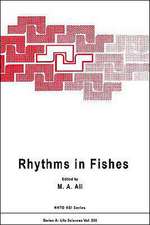The reproduction and development of sharks, skates, rays and ratfishes: Developments in Environmental Biology of Fishes, cartea 14
Editat de Leo S. Demski, John P. Wourmsen Limba Engleză Hardback – 31 oct 1993
| Toate formatele și edițiile | Preț | Express |
|---|---|---|
| Paperback (1) | 1053.05 lei 38-44 zile | |
| SPRINGER NETHERLANDS – 5 dec 2010 | 1053.05 lei 38-44 zile | |
| Hardback (1) | 1058.77 lei 38-44 zile | |
| SPRINGER NETHERLANDS – 31 oct 1993 | 1058.77 lei 38-44 zile |
Din seria Developments in Environmental Biology of Fishes
- 15%
 Preț: 632.01 lei
Preț: 632.01 lei - 18%
 Preț: 1230.21 lei
Preț: 1230.21 lei - 18%
 Preț: 1231.01 lei
Preț: 1231.01 lei -
 Preț: 406.05 lei
Preț: 406.05 lei - 24%
 Preț: 810.12 lei
Preț: 810.12 lei -
 Preț: 413.92 lei
Preț: 413.92 lei - 18%
 Preț: 956.69 lei
Preț: 956.69 lei - 18%
 Preț: 1236.99 lei
Preț: 1236.99 lei - 18%
 Preț: 1230.67 lei
Preț: 1230.67 lei - 18%
 Preț: 947.67 lei
Preț: 947.67 lei - 24%
 Preț: 787.44 lei
Preț: 787.44 lei - 24%
 Preț: 911.57 lei
Preț: 911.57 lei - 24%
 Preț: 1214.10 lei
Preț: 1214.10 lei - 18%
 Preț: 1237.61 lei
Preț: 1237.61 lei - 24%
 Preț: 1067.72 lei
Preț: 1067.72 lei - 15%
 Preț: 643.34 lei
Preț: 643.34 lei - 18%
 Preț: 954.14 lei
Preț: 954.14 lei - 18%
 Preț: 1220.88 lei
Preț: 1220.88 lei - 24%
 Preț: 805.40 lei
Preț: 805.40 lei - 18%
 Preț: 959.98 lei
Preț: 959.98 lei - 24%
 Preț: 830.79 lei
Preț: 830.79 lei - 24%
 Preț: 1036.49 lei
Preț: 1036.49 lei - 15%
 Preț: 634.00 lei
Preț: 634.00 lei - 24%
 Preț: 1043.51 lei
Preț: 1043.51 lei - 18%
 Preț: 1225.79 lei
Preț: 1225.79 lei - 24%
 Preț: 1470.77 lei
Preț: 1470.77 lei
Preț: 1058.77 lei
Preț vechi: 1393.12 lei
-24% Nou
Puncte Express: 1588
Preț estimativ în valută:
202.62€ • 210.76$ • 167.28£
202.62€ • 210.76$ • 167.28£
Carte tipărită la comandă
Livrare economică 10-16 aprilie
Preluare comenzi: 021 569.72.76
Specificații
ISBN-13: 9780792325093
ISBN-10: 0792325095
Pagini: 301
Ilustrații: 301 p. 106 illus., 3 illus. in color.
Dimensiuni: 193 x 260 x 23 mm
Greutate: 0.79 kg
Ediția:Reprinted from ENVIRONMENTAL BIOLOGY OF FISHES, 38:1-3, 1993
Editura: SPRINGER NETHERLANDS
Colecția Springer
Seria Developments in Environmental Biology of Fishes
Locul publicării:Dordrecht, Netherlands
ISBN-10: 0792325095
Pagini: 301
Ilustrații: 301 p. 106 illus., 3 illus. in color.
Dimensiuni: 193 x 260 x 23 mm
Greutate: 0.79 kg
Ediția:Reprinted from ENVIRONMENTAL BIOLOGY OF FISHES, 38:1-3, 1993
Editura: SPRINGER NETHERLANDS
Colecția Springer
Seria Developments in Environmental Biology of Fishes
Locul publicării:Dordrecht, Netherlands
Public țintă
ResearchCuprins
The reproduction and development of sharks, skates, rays and ratfishes: introduction, history, overview, and future prospects.- Fish imagery in art 52: Ellis’ Megamouth shark.- 1. Reproductive ecology and life history.- Geographic variation in reproduction between two populations of the bonnethead shark, Sphyrna tiburo.- The shark nursery of Bulls Bay, South Carolina, with a review of the shark nurseries of the southeastern coast of the United States.- Age and length at maturity of the female spiny dogfish, Squalus acanthias, in the Strait of Georgia, British Columbia, Canada.- Reproductive biology of the slender smoothhound, Gollum attenuatus, collected from New Zealand waters.- New data on the reproductive biology of the thorny stingray, Dasyatis centroura (Pisces: Dasyatidae) from off the Tunisian coast.- Reproductive biology of the guitarfish, Rhinobatos hynnicephalus.- Reproductive biology of lamnoid sharks.- 2. Structure and function of the reproductive system.- Predation on elasmobranch eggs.- Structure and functions of the genital ducts of the male Port Jackson shark, Heterodontus portusjacksoni.- The storage of spermatozoa in the oviducal glands of western North Atlantic sharks.- Stabilization and sclerotization of Raja erinacea egg capsule proteins.- Pre-copulatory behaviour of captive sandtiger sharks, Carcharias taures.- 3. Neural and endocrine control of reproduction.- Serum concentrations of reproductively-related circulating steroid hormones in the free-ranging lemon shark, Negaprion brevirostris.- Ovarian steroid synthesis and the hormonal control of the elasmobranch reproductive tract.- Morpho-functional aspects of the hypothalamus-pituitary-gonadal axis of elasmobranch fishes.- Gonadotropin-releasing hormone in cartilaginous fishes: structure,location, and transport.- Gonadotropin-releasing hormone (GnRH) pathways and reproductive control in elasmobranchs.- Clasper control in the round stingray, Urolophus halleri: lower sensorimotor pathways.- 4. Embryonic development and viviparity.- Ionic and osmotic environment of developing elasmobranch embryos.- Yolk utilization in Scyliorhinus canicula, an oviparous dogfish.- Ontogeny of the umbilical cord and placenta in the Atlantic sharpnose shark, Rhizoprionodon terraenovae.- Maximization of evolutionary trends for placental viviparity in the spadenose shark, Scoliodon laticaudus.- 1. Species and subject index.















